When the library asked me if I wanted to pick three of my favorite musical films for their annual “Spring Musicals” series, my first thought was that it was impossible to choose three favorites — not to mention the fact that a few years back, I’d convinced them to run one of the titles, Rouben Mamoulian’s Love Me Tonight (1932) — that would be on such a list. After some deliberation, I decided that instead, I’d pick three musicals that showcased the work of choreographer-turned-filmmaker Busby Berkeley.
The three I chose — Whoopee! (1930), Golddiggers of 1933 (1933) and The Gang’s All Here (1943) — represented different stages of Berkeley’s career. The first is little more than Berkeley repeating and expanding on the kind of thing he’d done in the 1920s on Broadway with another director, Thornton Freeland, handling the directorial chores. The second shows Berkeley in full-bloom as concerns his musical extravaganzas, but still with another director, Mervyn LeRoy, in charge of the non-musical scenes. The third features Berkeley in charge of the entire film. More than that, the films reflect three distinctly different eras — the simple “innocence” of the pre-Depression stage show, the Depression musical, and the war-time musical.
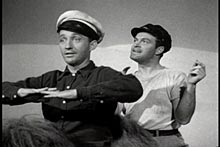
The process, however, got me thinking about the musical film in general and how a great many people absolutely can’t stand the genre. It’s a stance I’ve never understood, maybe because the first movies I responded to that weren’t horror pictures were the “Road” pictures with Bing and Bob and Dotty mixing comedy and songs in a world of studio-created exotica that stood in for South Sea islands, Africa, Alaska, Rio de Janeiro and Hong Kong. None of it seemed strange to me, but you may say that I was young and easily corrupted.
It may also just be that the range of movies offered to us at that time on television included a lot of musicals. Moreover, a lot of movies we encountered from the 1930s that weren’t musicals still thought nothing of suddenly injecting a song. A straightforward romantic comedy like Otto Preminger’s (yes, that Otto Preminger) Danger! Love at Work (1937) would suddenly have a musical number in mid-film and then go back to its original approach. It was this kind of attitude that made the big set piece in Alfred Hitchcock’s Young and Innocent (1937) work. No one went “what the hell?” when a musical number broke out, allowing Hitch to surprise you with the payoff at the end of that still amazing travelling shot.
I’m not, by the bye, putting forth a simple idea that this is necessarilly a generational thing. I know plenty of film fans of my generation who cross themselves and spit at the mere mention of the musical film. The usual excuse for their disdain is that musicals aren’t “realistic.” The irony that more often than not the person putting forth this supposedly damning charge has just finished waxing ecstatic over Lon Chaney, Jr.‘s transformation into a werewolf in Frankenstein Meets the Wolf Man (1943) seems to be lost on them. Of course, many of these same folks adore the Marx Brothers, and never consider that all of their films worthy of the term “a Marx Brothers picture” except Monkey Business (1931) are inescapably musicals.
The simple truth is that sound movies and music have always gone together quite nicely. Even before the movies learned to talk, they knew how to sing. The first uses of sound were for synchronized musical scores (the real idea behind sound films originally) and short films featuring popular singers. With the exception of Al Jolson’s A Plantation Act (1926) the efforts of these popular singers are today apt to make you wonder just who they were popular with, but that’s a separate cultural issue.
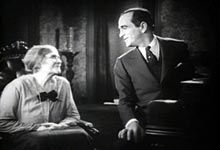
The movie generally referrred to as the first sound feature, The Jazz Singer (1927), is a mostly silent movie with a synchronized score (featuring large slabs of Tchaikovsky’s Romeo and Juliet Overture), a few songs and a smattering of dialogue that legend tells us was started when an overenthusiastic Al Jolson adlibbed, “Wait a minute, wait a minute. You ain’t heard nothin’ yet! Wait a minute, I tell ya, you ain’t heard nothin’! You wanna hear ‘Toot Toot Tootsie?’ All right, hold on, hold on.” It’s a great story — promulgated by Jolie himself — but the fact that the movie cuts to him saying it and that he’s overdubbed when he turns to musical director Lou Silver and adding, “Lou, listen, play ‘Toot Toot Tootsie’ — three choruses, you understand? In the third chorus, I whistle. Now, give it to ‘em hard and heavy,” makes its veracity doubtful. But then Jolson was never one to let the truth get in the way of a good story, especially if the story made him look good.
In a sense the first talkie, then, was a musical. It was a natural progression, since one of the few things a silent movie couldn’t be was a musical. And so with the advent of sound, the movies quickly found themselves with a new genre — and the mathematically unsound advertising slogan, “100% All Talking! All Singing! All Dancing!”
Even as a fan of the genre, I’ll admit this wasn’t inevitably a good thing. The start was clunky and often didn’t make good sense. Why, for example, did Universal make a straight part-talkie version of Show Boat in 1929, but base the film on the novel, not the stage musical, incorporate none of the songs, but present some of them (and not the more famous ones!) in a stagebound prologue? That’s just odd. And there were more than a few questionable artistic choice, few of which survive in the repertory today. (If you ever see Noah Beery, Sr. in blackface singing about his little whip in 1930’s Golden Dawn, you’ll know why.)
One that does survive is The Cocoanuts (1929), which is still shown because it stars the Marx Brothers. As a film, it’s pretty dismal. As a musical, it’s … quaint. “The Monkey Doodle-Do” is a catchy song and the number isn’t badly done, and boy, did somebody (the cameraman or the director) really like looking at the dancing girls’ backsides. But otherwise, it not only suffers from a largely immobile camera, but by following the concept put forth at the time by composer Irving Berlin. Berlin got it into his head that the future of the musical lay in movies with a very few songs — and those few would be repeated. As a result, Oscar Shaw and Mary Eaton perform “When My Dreams Come True” early in the film. Then Harpo plays it on a clarinet and later as a harp solo. The final scene opens with Eaton singing it again, and then the film can’t end without her having another outburst of it. By then, you’re ready to strangle her and slap Berlin.
The interesting thing is that it didn’t take all that long for audiences to have had enough. By 1931 theaters would proudly advertise “This is not a musical” whenever possible. Warner Bros. had bought Cole Porter’s stage show 50 Million Frenchmen, but by the time they filmed it in 1931 — complete with stage star William Gaxton — they made it as a comedy only with Porter’s songs used as background score.
The musical situation and early sound film was soundly satirized in the Moss Hart-George S. Kaufman play Once in a Lifetime, which interestingly (in that it directly satirizes studio head Carl Laemmle) Universal Picures made into a film 1932. (Unfortunately, the film, which is the movie 1952’s Singin’ in the Rain only thinks it is, is almost unknown today.) The whole “backstage musical” genre comes in for abuse. Late in the proceedings playwright Lawrence Vail (Onslow Stevens) refers to a film as “all talking, all singing,” and is interrupted by elocution teacher May Daniels (the divine Aline MacMahon) with, “all rotten,” prompting Vail to remark, “Guess that must be what they mean by a hundred percent.” Try slogging your way through 1929’s Best Picture winning The Broadway Melody sometime and you’ll know of what they speak.
Not all musicals were anathema, of course. The Maurice Chevalier pictures carried on unscathed, for example. On the other hand, Warner Bros., who’d “created talking pictures” (their claim) with Jolson parted company with Jolie after Big Boy (a bizarre recreation of his stage show that found the performer in blackface for the entire film) in 1930. Jolson wouldn’t work in movies again till 1933. But his closest rival, Eddie Cantor, kept right on knocking out a popular picture each year. There’s no denying that the Cantor films were just better, but Ol’ Banjo Eyes had a secret weapon — large production numbers created by Busby Berkeley. It was no surprise then that Berkeley would turn out to be the saviour of the musical film.
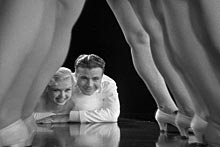
Busby Berkeley — and the Warner Bros. — made musicals cool again with 42nd Street in late 1933. The non-musical scenes moved like lightning and the comedy was rude (Ginger Rogers’ character, Anytime Annie, is described as only having said “no” once, “and then she didn’t hear the question”), while the drama was amusingly over-the-top. But the real selling point were Berkeley’s spectacular musical extravaganzas.
Berkeley had done some elaborate stagings before, but 42nd Street outdid them all. Though what he was creating invariably started and ended with a proscenium arch and a curtain, there was never any attempt at creating the illusion that what came in between was actually taking place on a stage, which was probably just as well, because not even the most credulous viewer would buy it. It didn’t matter, because he swept the audience up into the spectacle at hand. He wasn’t so much making musical numbers as he was making short films that fitted into the narrative of the film’s backstage story (though I defy anyone to make sense out of the shows being put on). In one regard, his numbers were the most outrageous fantasies and were totally unrealistic. In another sense, however, the films themselves were realistic — and for those bothered by such things, they rarely had people bursting into song and dance except on the supposed confines of a stage.
42nd Street is shrewdly structured not to give the game away as to what’s in store. We see rehearsals (which — and this remains a constant in the films to follow — have no relation to the show we finally see) and Bebe Daniels gets to sing a straightforward version of “You’re Getting to Be a Habit with Me,” but that’s it until the film hits the 70 minute mark. Here Berkeley gives us “Shuffle Off to Buffalo,” which is done in a fashion where the spectacle not only could be done on a stage, but retains that illusion, while being shot cinematically. With “Young and Healthy,” this shifts with Berkeley’s camera becoming the real star of the proceedings as it glides between the spread legs of the chorus girls onto a close-up of Dick Powell and Toby Wing.
The kicker, however, is the title number where Berkeley transitions from Ruby Keeler tap dancing in front of a backdrop to her being atop a taxi and the stage has suddenly become a huge city street set on a soundstage — with cars and cops on horses and a large cross-section of the habitues of 42nd Street. Berkeley stages mini-dramas as his camera glides up and peers into the windows of apartment houses and speakeasies. And it all climaxes with the camera tracking “up” the side of a skyscraper to an apparently gigantic Dick Powell and Ruby Keeler pulling down a fire curtain. There’d never been anything like it and it’s still astonishing today.
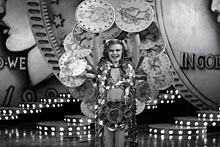
The formula was more or less repeated with Golddiggers of 1933, except that the film opened with a Berkeley number — “We’re in the Money” with, among other things, a disconcertingly gigantic close-up of Ginger Rogers singing the song in pig-Latin. The song is used ironically, because the thrust of this film is the Depression. In fact, the performance is interrupted when the costumes and scenery are repossessed. The Depression hangs over the whole film, despite the musical numbers and the upscale surroundings which come to dominate things in typical escapist fashion.
Since expectations were high and there was no surprise attached to the level of spectacle to be expected, Golddiggers delivered one of the set-piece numbers, “Pettin’ in the Park,” early on, before holding out for the plot to hold the film up to the last big numbers, “The Shadow Waltz” and “Remember My Forgotten Man.” Once the curtain goes up on these, there’s zero pretence of reality in terms of what happens, but the second has a different kind of reality. The escapist quality vanishes and Berkeley hits the audience with the reality of the Depression without comedy and without flinching. He may never have done anything finer. Her certainly never did anything as profoundly moving or important.
From there the formula stayed in place through Footlight Parade (1933), Dames (1934) and Wonder Bar (1934), altering slightly when Berkeley became a full-fledged director with Golddiggers of 1935. It was not the best of ideas. The musical numbers were still great. In fact, “Lullaby of Broadway” vies with “Remember My Forgotten Man” as Berkeley’s best. However, Berkeley just wasn’t much of a director when the music stopped. Some of the downturn can be attributed to the increased censorship of the Production Code. The dialogue and situations had to be toned down to conform. References to promiscuity (like Anytime Annie) and drugs (“Say what does he smoke? I’ll use it, too,” says Aline MacMahon at one point in Golddiggers of 1933) were gone. The plot got less grubby and a good deal sillier. But really, a lot of it rests on Berkeley being out of his depth away from the numbers.
It would never be the same and Berkeley worked out his contract making ever less spectacular programmers, finally ending up at MGM, where the studio’s established white-bread approach had no relation to his strengths. The numbers were sometimes big, but they were flat. And when he landed in the realm of Mickey Rooney-Judy Garland musicals, the stars were the stars, not Berkeley’s numbers.
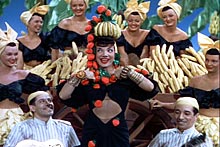
There would be one final outburst of the Berkeley genius, though, in 1943 when he went to 20th Century Fox to make The Gang’s All Here and met up with Technicolor and Carmen Miranda and her fruit-festooned hats. Again, the film suffered from Berkeley handing the straight portions as well as the musical numbers, but those numbers were something else again, especially “The Lady in the Tutti Fruiti Hat,” which was surprisingly sexual and a showcase for pop art before anyone knew what pop art was, and the kaleidoscopic finale, which was psychedelic before anyone knew what that was.
It’s hardly to be wondered that these films became iconic in the 1960s and 1970s when kids were discovering old movies. Yes, there was a built in camp value, but the films themselves were fast and funny, racy and rude, and felt very much counterculture — and the numbers were unlike anything then going.
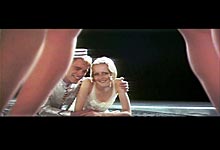
The only time anything like Berkeley hit the screen again was when Ken Russell made The Boy Friend with Twiggy for MGM in 1971. Russell deliberately emulated Berkeley’s work and expanded on it. Where Berkeley had one elaborate turntable of dancers, Russell would have two — side-by-side. He even evoked the camp value, duplicating situations and dialogue from 42nd Street. The results were both respectful and slyly humorous. Unfortunately — and unlike the Berkeley films — The Boy Friend has never been released on DVD. There was a properly letterboxed laserdisc, which won’t do most folks any good. The VHS release at least letterboxes the musical numbers, but unfortunately not the rest of the film. (Complain to MGM today!)
Those of you who “don’t like musicals,” ought to give Berkeley a try. You might just be surprised. I’ve used Golddiggers of 1933 — usually successfully — as an icebreaker for people who don’t like “old movies,” nevermind musicals. And if you still don’t like musicals, there’s probably just no hope for you. But I would be curious to know why — just don’t tell me it’s because they’re not realistic while you’re on your way out the door to see Iron Man.



Busby Berkeley rocks.
– Ken Russell
For myself, I had a dislike of musicals for a long time. My own theory is that this is due to my only exposure to musicals being Disney cartoons and occasionally being forced to watch stuff like THE SOUND OF MUSIC or FIDDLER ON THE ROOF or any number of movies with people singing show tunes, dancing and being overtly and forcibly happy (catch the MAMA MIA trailer if you need a good example of this) from elementary through high school.
It’s not a good place to start off with musicals — especially when you’re ten-years-old and are obsessed with GHOSTBUSTERS. Like any genre, there are tons of bad musicals that anyone could list off, but there are quite a few good ones, too. Not to mention there’s a big difference between stuff like TOMMY or ACROSS THE UNIVERSE as compared to, say, I dunno, RENT.
I also know people who love music but can’t stand musicals. I think there’s a bit of cheesiness that often goes along with the genre (I can’t remember the exact wording, but I know Ken’s told me he thinks all musicals should be a bit silly at some point, or something along those lines) that you have to give yourself up to if you’re going to enjoy the movie. At the same time, I’m not sure you’d want musicals to be dead serious anyway. How dreadful would a depressing, constantly dreary musical be?
My own theory is that this is due to my only exposure to musicals being Disney cartoons and occasionally being forced to watch stuff like THE SOUND OF MUSIC or FIDDLER ON THE ROOF or any number of movies with people singing show tunes, dancing and being overtly and forcibly happy (catch the MAMA MIA trailer if you need a good example of this) from elementary through high school.
There may be something to this. I’m trying to remember musicals I was dragged to in the theater. I know — from a particularly embarassing family story — that I must have seen Elvis in Loving You in 1957, but I don’t remember it. I do remember seeing Flower Drum Song (1961) and liking the kids and Jack Soo, and I remember seeing Lil’ Abner (1959) in a re-issue some time in the early 60s. (For some reason, I clearly remember being called in from digging in the backyard — why do children dig? — and asked if I wanted to go see that.) It was colorful and amusing rather than gooey and I liked it okay. I also remember seeing the 1962 version of State Fair and being bored to death. I really suspect it was seeing The Road to Hong Kong in 1962 and A Hard Day’s Night in 1964 that kept me from developing a distaste for the genre. Bing and Bob in their earlier adventures, the Marx Brothers, Mae West, Berkeley, Fred and Ginger, and a little later on the early sound musicals of Maurice Chevalier did the rest.
there’s a big difference between stuff like TOMMY or ACROSS THE UNIVERSE as compared to, say, I dunno, RENT.
That should be self-evident, but somehow it isn’t to a lot of people.
I know Ken’s told me he thinks all musicals should be a bit silly at some point, or something along those lines
Close at least. There’s a point in most good musicals — a make or break point — where the film lets the viewer laugh with its basic absurdity (in Tommy, for instance, it comes when the doctor joins in with the nurses on “It’s a Boy”) and prevents the viewer from laughing at it. (This, by the bye, is more important in the “pure” musical where characters just break into song than it is in “performance” musicals where the songs are part of a show.) Then again, I can’t think of a single movie in any genre I’d call great that wasn’t willing to risk being silly or ridiculous. It’s a risk you’ve got to run.
How dreadful would a depressing, constantly dreary musical be?
Brings us right back to Rent.
I love musicals… my all time favorite, “The Music Man.”
But I can watch almost any of the big studio musicals of the 30s and 40s … and let’s not forget the singing cowboy movies which were also musicals of sorts — Gene Autry, Tex Ritter, John Wayne (YEP, the Duke make several, but his voice was dubbed as he could not carry a tune but darned if he couldn’t act).
I agree with Ken, don’t see why viewers today do not like musicals???
I agree with Ken, don’t see why viewers today do not like musicals???
Well, I think today’s viewers are at least a little more receptive than they were in the 80s and 90s. After Milos Forman’s Hair in 1979, what was there? Annie? (God save us.) There was Julien Temple’s very odd failure, Absolute Beginners in 1987, which — to judge by his marvelous Kinks video “Come Dancing” (my vote for best music video ever) — ought to have been better than it was. And speaking of the Kink’s there was Ray Davies’ almost experimental Return to Waterloo (1985). And there’s Altman’s Popeye from 1980.
Starting with Moulin Rouge! in 2001, though, we’ve seen a sort of resurgence in quantity, if not always in quality. We’ve had Hedwig and the Angry Inch, Chicago, Rent, Delovely, Beyond the Sea, The Producers, Hairspray and Across the Universe. (Am I forgetting something?) To be honest, of these I only really like Moulin Rouge!, Hedwig and Across the Universe without reservation. I don’t like Rent or Beyond the Sea at all. Still, that’s more than one a year for a while now and that’s encouraging.
Busby Berkeley rocks.
– Ken Russell
Far be it from me to argue with Ken Russell (well, about Moulin Rouge! maybe), but I wouldn’t in this case anyway.
And don’t forget, I’ll be showing Berkeley rocking at 6 p.m. tonight at Pack Library in Lord Auditorium with Whoopee!.
Justin/Ken,
I’ll try and kill two birds with one stone here–how ’bout a depression-set (and equally “depressing”) musical made in 1981…? I might add, a “pure” musical.
Herbert Ross’s “Pennies From Heaven,” with Steve Martin not-too-far removed from being a “wild and crazy guy” and straight from “The Jerk.”
Personal comedic tastes aside, I suppose one has to be of a certain age to fully grasp what a huge, huge stand-up act Martin was in the late 70’s. For him to “try” to make the transition into this particular dramatic work–a musical no less–was certainly daring, if not commercially successful. And, then, the next year, Martin went on to a personal favrite of mine (largely forgotten and, most decidely, not a musical), “Dead Men Don’t Wear Plaid”…
Q: “What is ‘fok’?
A: Well, it’s when a man and a woman…”
“Pennies” is awfully serious in tone–great set-pieces, but a real downer. This movie is also notable because we get to see classically trained dancer Christopher Walken strutting on screen as the “villain.”
I’ll try and kill two birds with one stone here–how ‘bout a depression-set (and equally “depressing”) musical made in 1981…? I might add, a “pure” musical.
It’s a pure musical in the sense that, yes, the songs arise out of the story and aren’t simply musical numbers being performed on a stage, but it’s also something of a stunt picture (as was the Brit TV series it was based on) since all the songs involve the actors lip-synching to period recordings. Not sure that that rules it out — any movie that uses Arthur Tracy (“The Street Singer”) singing “Pennies from Heaven” has to get bonus points. But it does seem more of a novelty than anything else. And though it was a big deal with either AMERICAN FILM or FILM COMMENT when it was about to come out (one of them had a big spread on it), I don’t think it did well at the box office, which is perhaps beside the point.
I do have to say that I really just don’t like the movie much. I saw it again recently on TCM, hoping to like it better than I had originally and, no, I didn’t. I don’t think it’s because it’s a downer (though it is). I don’t like a lot of the choreography for one thing. But the big problem for me is that I find Steve Martin an incredibly unsympathetic performer — and no film has ever been able to get me past that feeling.
If we’re comparing it to — as a Depression musical — to Golddiggers of 1933, I think it’s essential to note one huge difference. There’s nothing particularly bold about addressing the Depression in 1981. There is something bold about doing so in 1933. It also strikes me as the lesser work because the whole film is bathed in grimness. Golddiggers goes from being ironic (“We’re in the Money”) to being acidly funny about the Depression to offering an escapist comedy fantasy that ignores the Depression and then finally turns around and slaps you in the face — through one production number — with the reality of 1933. I find that much more effective. I was talking about the picture with a friend of mine last week and he pointed out that he finds the film’s ending far more shattering than the much-cited one on I Am a Fugitive from a Chain Gang (1932) where we see Paul Muni slink away into the dark answering the question of how he lives by saying, “I steal.” I can’t help but think it’s the shift in tone that plays the major role in his response. I know that’s part of the reason Pennies doesn’t work so well for me. It’s always bitter, always ironic.
THE BOYFRIEND rocks!
The “dream” sequence messed me up for awhile… and that’s a good thing.
We carry a healthy share of Berkeley and you’ll be pleased to know that he is finding new fans all the time.
The “dream” sequence messed me up for awhile… and that’s a good thing.
Which one??? The Bachanal? The “Pixieland” sequence?
We carry a healthy share of Berkeley and you’ll be pleased to know that he is finding new fans all the time.
That does please me, but I’m not entirely surprised. Though the audience at the library for Whoopee! was primarily older people the other night (something I put down as much to the awkward 6 p.m. showtime as anything), there was one young man, who afterwards registered disappointment that we weren’t going to be run Dames.
“Which one??? The Bachanal? The “Pixieland” sequence?”
Definitely the Bachanal.
Definitely the Bachanal.
Interestingly, the Bachanal — along with other things totally 28 minutes of footage — was not in the original 109 minute U.S. release print of the film. In fact, the 137 minute version of The Boy Friend didn’t show up in the States until almost 1990.
Yeah, I saw the MGM vhs.
Ken Russell if you’re still around on this thread, thank you!
Ken Russell if you’re still around on this thread, thank you!
I’m pretty sure he’s reading it.